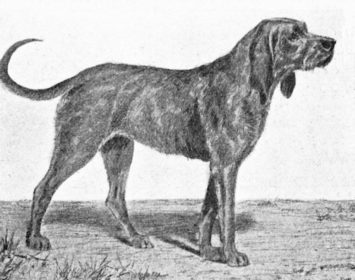
By all accounts, “dun” is a dull grayish-brown color, and it follows that “Dun Hounds” would be grayish brown dogs.
You can’t be blamed for not knowing what a Dun Hound is. In the 16th century, George Turberville translated Count Jacques du Fouilloux’s popular book on hunting into English, and when he came to the word, “Chien-gris,” he used “Dun hound” as the English translation.
You shouldn’t be faulted for not knowing what a “Chien-gris” is, either, they’re extinct. These scenthounds, also known as Grey St. Louis Hounds, originated in Medieval times and eventually faded into history because of the revolution on French hunting, and crossbreeding. Still, the Dun Hound merited mention some two hundred years later in Charles Butler’s 19th century book, Dog Fanciers Companion:
“Dun Hounds are good for all chases, and therefore of general use. The best coloured are such as are dun, on the back, having their fore-quarters tanned, or of the complexion of a hare’s legs; but if the hair on the back be black, and their legs freckled with red and black, they then usually prove excellent hounds…”
Enter the Crusaders. Following their pilgrimages to the Holy Land, these men, many of them knights, returned to England with dogs that were the likely ancestors of the greyish Dun Hounds. Why Dun Hounds are of interest to us is because they factor into the early history of a breed you do know, the Bloodhound.
Bloodhounds were known in Europe long before the Crusades, as were their ancestors, Hubert Hounds established in the 7th century in Ardennes, France. A monk, Francois Hubert, developed the Hubert Hounds from stock he may have gotten in southern France. After Hubert’s death, the dogs continued to be bred by the abbots who succeeded him.
At first these dogs were black, but eventually the dogs developed small tan markings that increased in size over time. The dogs brought back by the Crusaders were blended with early lines, and today’s Bloodhounds are descended from those hounds.
The true St. Hubert strain, according to Catherine F. Brey and Lena F. Reed, survived into the 19th century, but St. Hubert’s Day, (St. Hubert’s, now the patron saint of hunters) is celebrated on November 3rd in France, Belgium and Ireland to this day.
Having said all this, we would be remiss in not mentioning that some cynologists are of the opinion that Hubert Hounds were developed by carefully breeding local French hounds with an occasional foreign dog (perhaps the Dun Hound?) with desirable traits added to the bloodlines. They point out that there are no Middle Eastern dog breeds which resemble depictions of the Saint Hubert Hound. Other experts believe that Hubert Hounds were crossed with white hounds to produce early Talbot Hounds, also ancestors of the modern Bloodhound.
We may never be known with certainty what the precise recipe was to produce an outstanding breed like the Bloodhound, but we’re very glad it exists.
Image: A Gris De Saint-Louis Hound from 1915
